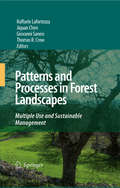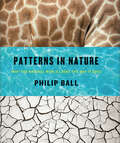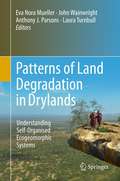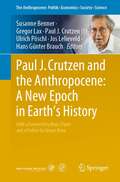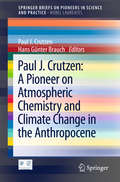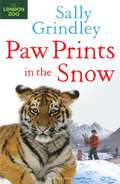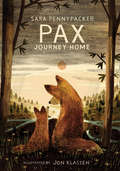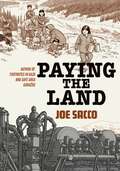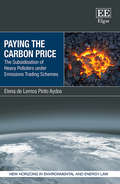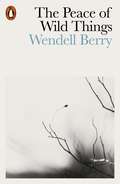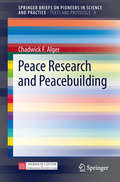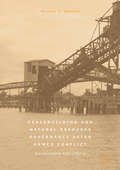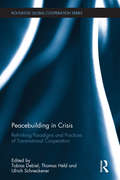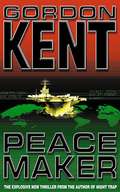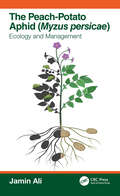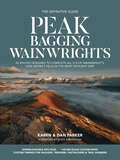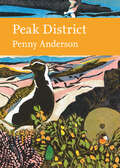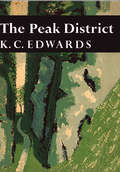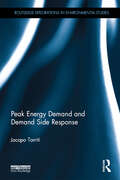- Table View
- List View
Patterns and Processes in Forest Landscapes: Multiple Use and Sustainable Management
by Raffaele Lafortezza Jiquan Chen Thomas R. Crow Giovanni Sanesi Thomas A. SpiesIncreasing evidence suggests that the composition and spatial configuration – the pattern – of forest landscapes affect many ecological processes, including the movement and persistence of particular species, the susceptibility and spread of disturbances such as fires or pest outbreaks, and the redistribution of matter and nutrients. Understanding these issues is key to the successful management of complex, multifunctional forest landscapes, and landscape ecology, based on a foundation of island bio-geography and meta-population dynamic theories, provides the rationale to deal with this pattern-to-process interaction at different spatial and temporal scales. This carefully edited volume represents a stimulating addition to the international literature on landscape ecology and resource management. It provides key insights into some of the applicable landscape ecological theories that underlie forest management, with a specific focus on how forest management can benefit from landscape ecology, and how landscape ecology can be advanced by tackling challenging problems in forest (landscape) management. It also presents a series of case studies from Europe, Asia, North America, Africa and Australia exploring the issues of disturbance, diversity, management, and scale, and with a specific focus on how human intervention affects forest landscapes and, in turn, how landscapes influence humans and their culture. An important reference for advanced students and researchers in landscape ecology, conservation biology, forest ecology, natural resource management and ecology across multiple scales, the book will also appeal to researchers and practitioners in reserve design, ecological restoration, forest management, landscape planning and landscape architecture.
Patterns in Nature: Why the Natural World Looks the Way It Does
by Philip BallThough at first glance the natural world may appear overwhelming in its diversity and complexity, there are regularities running through it, from the hexagons of a honeycomb to the spirals of a seashell and the branching veins of a leaf. Revealing the order at the foundation of the seemingly chaotic natural world, Patterns in Nature explores not only the math and science but also the beauty and artistry behind nature’s awe-inspiring designs. Unlike the patterns we create in technology, architecture, and art, natural patterns are formed spontaneously from the forces that act in the physical world. Very often the same types of pattern and form – spirals, stripes, branches, and fractals, say—recur in places that seem to have nothing in common, as when the markings of a zebra mimic the ripples in windblown sand. That’s because, as Patterns in Nature shows, at the most basic level these patterns can often be described using the same mathematical and physical principles: there is a surprising underlying unity in the kaleidoscope of the natural world. Richly illustrated with 250 color photographs and anchored by accessible and insightful chapters by esteemed science writer Philip Ball, Patterns in Nature reveals the organization at work in vast and ancient forests, powerful rivers, massing clouds, and coastlines carved out by the sea. By exploring similarities such as those between a snail shell and the swirling stars of a galaxy, or the branches of a tree and those of a river network, this spectacular visual tour conveys the wonder, beauty, and richness of natural pattern formation.
Patterns in Nature: Why the Natural World Looks the Way It Does
by Philip BallThough at first glance the natural world may appear overwhelming in its diversity and complexity, there are regularities running through it, from the hexagons of a honeycomb to the spirals of a seashell and the branching veins of a leaf. Revealing the order at the foundation of the seemingly chaotic natural world, Patterns in Nature explores not only the math and science but also the beauty and artistry behind nature’s awe-inspiring designs. Unlike the patterns we create in technology, architecture, and art, natural patterns are formed spontaneously from the forces that act in the physical world. Very often the same types of pattern and form – spirals, stripes, branches, and fractals, say—recur in places that seem to have nothing in common, as when the markings of a zebra mimic the ripples in windblown sand. That’s because, as Patterns in Nature shows, at the most basic level these patterns can often be described using the same mathematical and physical principles: there is a surprising underlying unity in the kaleidoscope of the natural world. Richly illustrated with 250 color photographs and anchored by accessible and insightful chapters by esteemed science writer Philip Ball, Patterns in Nature reveals the organization at work in vast and ancient forests, powerful rivers, massing clouds, and coastlines carved out by the sea. By exploring similarities such as those between a snail shell and the swirling stars of a galaxy, or the branches of a tree and those of a river network, this spectacular visual tour conveys the wonder, beauty, and richness of natural pattern formation.
Patterns in Nature: Why the Natural World Looks the Way It Does
by Philip BallThough at first glance the natural world may appear overwhelming in its diversity and complexity, there are regularities running through it, from the hexagons of a honeycomb to the spirals of a seashell and the branching veins of a leaf. Revealing the order at the foundation of the seemingly chaotic natural world, Patterns in Nature explores not only the math and science but also the beauty and artistry behind nature’s awe-inspiring designs. Unlike the patterns we create in technology, architecture, and art, natural patterns are formed spontaneously from the forces that act in the physical world. Very often the same types of pattern and form – spirals, stripes, branches, and fractals, say—recur in places that seem to have nothing in common, as when the markings of a zebra mimic the ripples in windblown sand. That’s because, as Patterns in Nature shows, at the most basic level these patterns can often be described using the same mathematical and physical principles: there is a surprising underlying unity in the kaleidoscope of the natural world. Richly illustrated with 250 color photographs and anchored by accessible and insightful chapters by esteemed science writer Philip Ball, Patterns in Nature reveals the organization at work in vast and ancient forests, powerful rivers, massing clouds, and coastlines carved out by the sea. By exploring similarities such as those between a snail shell and the swirling stars of a galaxy, or the branches of a tree and those of a river network, this spectacular visual tour conveys the wonder, beauty, and richness of natural pattern formation.
Patterns in Nature: Why the Natural World Looks the Way It Does
by Philip BallThough at first glance the natural world may appear overwhelming in its diversity and complexity, there are regularities running through it, from the hexagons of a honeycomb to the spirals of a seashell and the branching veins of a leaf. Revealing the order at the foundation of the seemingly chaotic natural world, Patterns in Nature explores not only the math and science but also the beauty and artistry behind nature’s awe-inspiring designs. Unlike the patterns we create in technology, architecture, and art, natural patterns are formed spontaneously from the forces that act in the physical world. Very often the same types of pattern and form – spirals, stripes, branches, and fractals, say—recur in places that seem to have nothing in common, as when the markings of a zebra mimic the ripples in windblown sand. That’s because, as Patterns in Nature shows, at the most basic level these patterns can often be described using the same mathematical and physical principles: there is a surprising underlying unity in the kaleidoscope of the natural world. Richly illustrated with 250 color photographs and anchored by accessible and insightful chapters by esteemed science writer Philip Ball, Patterns in Nature reveals the organization at work in vast and ancient forests, powerful rivers, massing clouds, and coastlines carved out by the sea. By exploring similarities such as those between a snail shell and the swirling stars of a galaxy, or the branches of a tree and those of a river network, this spectacular visual tour conveys the wonder, beauty, and richness of natural pattern formation.
Patterns of Land Degradation in Drylands: Understanding Self-Organised Ecogeomorphic Systems
by Eva Nora Mueller John Wainwright Anthony J. Parsons Laura TurnbullThis book explores the theory of ecogeomorphic pattern-process linkages, using case studies from Europe, Africa, Australia and North America. Sets forth a research agenda for the emerging field of ecogeomorphology in drylands land-degradation studies.
Paul J. Crutzen and the Anthropocene: A New Epoch in Earth’s History (The Anthropocene: Politik—Economics—Society—Science #1)
by Hans Günter Brauch Paul J. Crutzen Susanne Benner Gregor Lax Ulrich Pöschl Jos LelieveldThis book outlines the development and perspectives of the Anthropocene concept by Paul J. Crutzen and his colleagues from its inception to its implications for the sciences, humanities, society and politics.The main text consists primarily of articles from peer-reviewed scientific journals and other scholarly sources. It comprises selected articles on the Anthropocene published by Paul J. Crutzen and a selection of related articles, mostly but not exclusively by colleagues with whom he collaborated closely.• In the year 2000 Nobel Laureate Paul J. Crutzen proposed the Anthropocene concept as a new epoch in Earth’s history • Comprehensive collection of articles on the Anthropocene by Paul J. Crutzen and his colleagues• Unique primary research literature and Crutzen’s comprehensive bibliography• Paul Crutzen’s scientific investigations into human influences on atmospheric chemistry and physics, the climate and the Earth system, leading to the conception of the Anthropocene• Reflections on the Anthropocene and its implications• Bibliometric review of the spread of the use of the Anthropocene concept in the Natural and Social Sciences, Humanities and Law
Paul J. Crutzen: A Pioneer on Atmospheric Chemistry and Climate Change in the Anthropocene (SpringerBriefs on Pioneers in Science and Practice #50)
by Paul J. Crutzen Hans Günter BrauchThis book contains texts by the Nobel laureate Paul J. Crutzen who is best known for his research on ozone depletion. It comprises Crutzen’s autobiography, several pictures documenting important stages of his life, and his most important scientific publications. The Dutch atmospheric chemist is one of the world’s most cited scientists in geosciences. His political engagement makes him a tireless ambassador for environmental issues such as climate change. He popularized the term ‘Anthropocene’ for the current geological era acknowledging the enduring influence of humankind on planet Earth. This concept conceives humans to be a geologic factor, influencing the evolution of our globe and the living beings populating it. The selection of texts is representing Paul Crutzen´s scientific oeuvre as his research interests span from ozone depletion to the climatic impacts of biomass burning, the consequences of a worldwide atomic war – the Nuclear Winter - to geoengineering and the Anthropocene.
Paw Prints in the Snow
by Sally GrindleyTwo children accompany their parents as they travel the world helping animals on the verge of extinction. As their parents work alongside international agencies, the children have their own thrilling adventures. Paw Prints in the Snow is written with the assistance and guidance of London Zoo's conservation team. All information is accurate and the stories are full of excitement and tension.Sally Grindley is the author of bestselling and award-winning fiction for young readers. Here she brings to life a story of hope set in Russia.When Joe and Aesha's mother is given an assignment to train young vets, the Brook family visits an important nature reserve near Lazovsky in eastern Russia. In this spectacular snow-bound landscape, Joe is thrilled by the prospect of glimpsing a rare Amur tiger in the wild. Alongside the fieldworkers, the Brooks get involved in tracking local species, such as the Asiatic black bear and the raccoon dog. However, the tigers prove elusive - until Joe's interest in wildlife photography leads him to make an unexpected discovery that puts his very life in danger.
Pax, Journey Home
by Sara PennypackerFrom bestselling and award-winning author Sara Pennypacker comes the long-awaited sequel to Pax; gorgeously crafted, utterly compelling with stunning illustrations by award-winning author and illustrator Jon Klassen.
Paying The Land
by Joe SaccoThe Dene have lived in the vast Mackenzie River Valley since time immemorial, by their account. To the Dene, the land owns them, not the other way around-it is central to their livelihood and their very way of being. But the subarctic Canadian Northwest Territories are also home to valuable natural resources, including oil, gas and diamonds. With mining came jobs and investment-but also road-building, pipelines and toxic waste, which scarred the landscape; and alcohol, drugs, and debt, which deformed a way of life. In Paying the Land, Joe Sacco travels the frozen North to reveal a people in conflict over the costs and benefits of development. Resource extraction is only part of Canada's colonial legacy- Sacco recounts the shattering impact of a residential school system that aimed to remove the Indian from the child; the destructive process that drove the Dene from the bush into settlements and turned them into wage labourers; the government land claims stacked against the Dene Nation; and their uphill efforts to revive a wounded culture. Against a vast and gorgeous landscape that dwarfs all human scale, Paying the Land lends an ear to trappers and chiefs, activists and priests, telling a sweeping story about money and dependency, loss and culture, with stunning visual detail by one of the greatest comic's reporters alive.
Paying the Carbon Price: The Subsidisation of Heavy Polluters under Emissions Trading Schemes (New Horizons in Environmental and Energy Law series)
by Elena de Lemos Pinto AydosPaying the Carbon Price analyses the practice of freely allocating permits in Emissions Trading Schemes (ETSs) and demonstrates how many heavy polluters participating in ETSs are not yet paying the full price of carbon. This innovative book provides a framework to assist policymakers in the design of transitional assistance measures that are both legally robust and will support the effectiveness of the ETSs whilst limiting negative impacts on international trade. Within the realm of international and comparative law, this book closes the gap between the legal frameworks of ETSs in practice, the economic research data and the doctrinal analysis of WTO law. These interesting insights and fresh ideas explore the connection between ETSs, the problems with free allocation of emission permits and the analysis of complex legal instruments. This accessible resource will be invaluable for those researching and teaching climate change law and policy, international trade law and environmental economics. It will also be a useful tool for policymakers, lawyers and economists.
The Peace of Wild Things: And Other Poems
by Wendell BerryIf you stop and look around you, you'll start to see. Tall marigolds darkening. A spring wind blowing. The woods awake with sound. On the wooden porch, your love smiling. Dew-wet red berries in a cup. On the hills, the beginnings of green, clover and grass to be pasture. The fowls singing and then settling for the night. Bright, silent, thousands of stars. You come into the peace of simple things. From the author of the 'compelling' and 'luminous' essays of The World-Ending Fire comes a slim volume of poems. Tender and intimate, these are consoling songs of hope and of healing; short, simple meditations on love, death, friendship, memory and belonging. They celebrate and elevate what is sensuous about life, and invite us to pause and appreciate what is good in life, to stop and savour our fleeting moments of earthly enjoyment. And, when fear for the future keeps us awake at night, to come into the peace of wild things.
Peace Research and Peacebuilding (SpringerBriefs on Pioneers in Science and Practice #9)
by Chadwick F AlgerThis is the third volume to commemorate the 90th birthday of the distinguished scholar Chadwick F. Alger to honor his lifetime achievement in international relations, as President of the International Studies Association (1978-1979) and as Secretary General of the International Peace Research Association (1984-1987). After a brief introduction by Chad F. Alger this volume presents six of his key texts on Peace Research and Peacebuilding, covering “The quest for peace: What are we learning?”; “The Emerging Toolchest for Peacebuilders”; “Peace Studies as a Transdisciplinary Project”; “Challenges for Peace Researchers and Peace Builders in the Twenty-First Century: Education and Coordination of a Diversity of Actors in Applying What We Are Learning”; “The escalating peace potential of global governance”, “There Are Peacebuilding Tasks for Everybody”, and “What Should Be the Foundations of Peace Education?”
Peacebuilding and Natural Resource Governance After Armed Conflict: Sierra Leone and Liberia
by Michael D. BeeversThis book argues that a set of persuasive narratives about the links between natural resource, armed conflict and peacebuilding have strongly influenced the natural resource interventions pursued by international peacebuilders. The author shows how international peacebuilders active in Liberia and Sierra Leone pursued a collective strategy to transform “conflict resources” into “peace resources” vis-à-vis a policy agenda that promoted “securitization” and “marketization” of natural resources. However, the exclusive focus on securitization and marketization have been counterproductive for peacebuilding since these interventions render invisible issues connected to land ownership, environmental protection and sustainable livelihoods and mirror pre-war governing arrangements in which corruption, exclusion and exploitation took root. Natural resource governance and peacebuilding must go beyond narrow debates about securitization and marketization, and instead be a catalyst for trust–building and cooperation that has a local focus, and pursues an inclusive agenda that not only serves the cause of peace, but the cause of people.
Peacebuilding and Natural Resource Governance After Armed Conflict: Sierra Leone and Liberia
by Michael D. BeeversThis book argues that a set of persuasive narratives about the links between natural resource, armed conflict and peacebuilding have strongly influenced the natural resource interventions pursued by international peacebuilders. The author shows how international peacebuilders active in Liberia and Sierra Leone pursued a collective strategy to transform “conflict resources” into “peace resources” vis-à-vis a policy agenda that promoted “securitization” and “marketization” of natural resources. However, the exclusive focus on securitization and marketization have been counterproductive for peacebuilding since these interventions render invisible issues connected to land ownership, environmental protection and sustainable livelihoods and mirror pre-war governing arrangements in which corruption, exclusion and exploitation took root. Natural resource governance and peacebuilding must go beyond narrow debates about securitization and marketization, and instead be a catalyst for trust–building and cooperation that has a local focus, and pursues an inclusive agenda that not only serves the cause of peace, but the cause of people.
Peacebuilding in Crisis: Rethinking Paradigms and Practices of Transnational Cooperation (Routledge Global Cooperation Series)
by Thomas Held Tobias Debiel Ulrich SchneckenerThe 1990s saw a constant increase in international peace missions, predominantly led by the United Nations, whose mandates were more and more extended to implement societal and political transformations in post-conflict societies. However, in many cases these missions did not meet the high expectations and did not acquire a sufficient legitimacy on the local level. Written by leading experts in the field, this edited volume brings together ‘liberal’ and ‘post-liberal’ approaches to peacebuilding. Besides challenging dominant peacebuilding paradigms, the book scrutinizes how far key concepts of post-liberal peacebuilding offer sound categories and new perspectives to reframe peacebuilding research. It thus moves beyond the ‘liberal’–‘post-liberal’ divide and systematically integrates further perspectives, paving the way for a new era in peacebuilding research which is theory-guided, but also substantiated in the empirical analysis of peacebuilding practices. This book will be essential reading for postgraduate students and scholar-practitioners working in the field of peacebuilding. By embedding the subject area into different research perspectives, the book will also be relevant for scholars who come from related backgrounds, such as democracy promotion, transitional justice, statebuilding, conflict and development research and international relations in general.
Peacebuilding in Crisis: Rethinking Paradigms and Practices of Transnational Cooperation (Routledge Global Cooperation Series)
by Thomas Held Tobias Debiel Ulrich SchneckenerThe 1990s saw a constant increase in international peace missions, predominantly led by the United Nations, whose mandates were more and more extended to implement societal and political transformations in post-conflict societies. However, in many cases these missions did not meet the high expectations and did not acquire a sufficient legitimacy on the local level. Written by leading experts in the field, this edited volume brings together ‘liberal’ and ‘post-liberal’ approaches to peacebuilding. Besides challenging dominant peacebuilding paradigms, the book scrutinizes how far key concepts of post-liberal peacebuilding offer sound categories and new perspectives to reframe peacebuilding research. It thus moves beyond the ‘liberal’–‘post-liberal’ divide and systematically integrates further perspectives, paving the way for a new era in peacebuilding research which is theory-guided, but also substantiated in the empirical analysis of peacebuilding practices. This book will be essential reading for postgraduate students and scholar-practitioners working in the field of peacebuilding. By embedding the subject area into different research perspectives, the book will also be relevant for scholars who come from related backgrounds, such as democracy promotion, transitional justice, statebuilding, conflict and development research and international relations in general.
Peacemaker
by Gordon KentFrom the acclaimed author of Night Trap, the second exhilarating tale of modern espionage and military adventure featuring US Navy intelligence officer Alan Craik.
The Peach Potato Aphid (Myzus persicae): Ecology and Management
by Jamin AliConsidered as economically significant pests with worldwide distribution, aphids feed on hundreds of cultivated and ornamental plants and cause considerable economic loss on a global scale. The peach-potato aphid, Myzus persicae, is one of the most severe model aphid pests and successfully colonizes hundreds of plant species from 40 different families. It is a complex aphid pest known for its high reproductive rate, biotype formation, suppression of plant defenses, and wide range of host plants. This book covers ecological aspects - including life cycle, damage, and host range - which make aphids an economically important pest. A wide range of topics are covered, including ecological aspects of M. persicae; challenges with management approaches; damage; suppression of plant defenses; evolution; the mechanism of resistance against major classes of insecticides; the potential of biological control and natural plant-derived compounds (plant defense elicitors) as an alternative to the use of synthetic chemical insecticides to control M. persicae; and integrated pest management for M. persicae. As the peach-potato aphid is a model aphid pest, studying it helps to develop control strategies against the entire group of aphids. Written for professionals, as well as students, teachers, and researchers in the fields of entomology, ecology, and bioscience, this book is an enriching new addition to its field.
The Peach Potato Aphid (Myzus persicae): Ecology and Management
by Jamin AliConsidered as economically significant pests with worldwide distribution, aphids feed on hundreds of cultivated and ornamental plants and cause considerable economic loss on a global scale. The peach-potato aphid, Myzus persicae, is one of the most severe model aphid pests and successfully colonizes hundreds of plant species from 40 different families. It is a complex aphid pest known for its high reproductive rate, biotype formation, suppression of plant defenses, and wide range of host plants. This book covers ecological aspects - including life cycle, damage, and host range - which make aphids an economically important pest. A wide range of topics are covered, including ecological aspects of M. persicae; challenges with management approaches; damage; suppression of plant defenses; evolution; the mechanism of resistance against major classes of insecticides; the potential of biological control and natural plant-derived compounds (plant defense elicitors) as an alternative to the use of synthetic chemical insecticides to control M. persicae; and integrated pest management for M. persicae. As the peach-potato aphid is a model aphid pest, studying it helps to develop control strategies against the entire group of aphids. Written for professionals, as well as students, teachers, and researchers in the fields of entomology, ecology, and bioscience, this book is an enriching new addition to its field.
Peak Bagging: 45 routes designed to complete all 214 of Wainwright's Lake District fells in the most efficient way
by Karen Parker Dan ParkerOver fifty years ago, renowned British hillwalker and guidebook author Alfred Wainwright described 214 peaks in the English Lake District in his seven-volume illustrated Pictorial Guide to the Lakeland Fells. Like the Munros in Scotland, bagging all the Wainwrights has become a popular and significant challenge for walkers and runners, often taking many years in fits and starts because of the absence of a clear plan for how to link them together.With this problem in mind, Peak Bagging: Wainwrights by Karen and Dan Parker features forty-five routes designed to link up these iconic fells so you can enjoy the challenge of completing them at your own pace – over years, months or even just a few weeks. It presents not only the most efficient routes for completing the Wainwrights as quickly as possible, but does so in such a way that each route is a fantastic walk or run in its own right. The featured routes include a round of the Scafells, and the Glenridding Horseshoe, taking in Helvellyn and Catstycam.The routes are split into seven sections, reflecting Wainwright’s seven Pictorial Guides, and to simplify logistics, all of the featured routes are circular with an emphasis on making practical links between the summits. In addition, the book is packed with useful information, including 1:40,000-scale maps, elevation profiles, public transport and parking details, refreshments, downloadable GPX files for each route and custom timings for walkers, trekkers, fastpackers and runners. Also included are overview details of Steve Birkinshaw’s then-record-breaking sub-seven-day Wainwrights run in 2014 – current record holder Sabrina Verjee completed the round in under six days. Whatever your timescale for completing the 214 Wainwrights, Peak Bagging: Wainwrights is the indispensable guide to this British hill challenge.
Peak District (Collins New Naturalist Library)
by Penny AndersonThe Peak District, Britain’s first national park, is a land of great natural beauty, visited by millions of people every year.
The Peak District (Collins New Naturalist Library #44)
by K. C. EdwardsA survey of great interest to naturalists and to the thousands of ramblers who visit the Peak District.
Peak Energy Demand and Demand Side Response (Routledge Explorations in Environmental Studies)
by Jacopo TorritiWith different intensities, depending on the season, every morning and evening of any weekday there are the same peaks in electricity demand. Peaks can bring about significantly negative environmental and economic impacts. Demand Side Response is a relatively recent solution in Europe which has the potential to reduce peak demand and ease impending capacity shortages. Peak Energy Demand and Demand Side Response presents evidence on a set of Demand Side Response activities, ranging from price-based to incentive-based programmes and policies. Examples are drawn from different programmes for both residential and non-residential sectors of electricity demand, including Time of Use tariffs, Critical Peak Pricing Automated Demand Controllers and Ancillary Services. The book also looks at the actual energy saving impacts of smart meters, the activities which constitute peak demand and the potential opportunities associated with European smart grids and Capacity Markets. This is the first book presenting comprehensive analysis of the impacts, cost benefits and risks associated with Demand Side Response programmes and policies. It should be of interest to students, scholars and policy-makers in the areas of energy, environmental economics and applied economics.
